Ahoy, squirts! Quint here. One of the things I did during my holiday downtime was to attack a big project I've been putting off since I moved into my house: organize the garage. I've lived in my house for almost 5 years and have yet to actually use my garage as a place to put my car since I have so many boxes of junk. I was bound and determined to clear that sumbitch out. A couple hundred dollars worth of heavy duty shelving and storage bins later and I'm about 80% of the way through this project.
It sounds super boring and grown up, but since I'm a mega nerd that meant I was going to dig up a ton of nerdy stuff. I've found yearbooks, boxes of toys, collectibles, books, comics and even some of my rarer pieces, like a promo book sent out to distributors by Universal in 1973.
The purpose of these books was to get theater owners excited about a studio's upcoming slate so they'd make sure to book these films on their screens. The studios would tout their current successes and show off upcoming films either in production or development.
What's interesting about that approach is you'll find poster art for movies that never made it through development. If you've been following my writing at all you'll know that I've been fascinated with these movies that never happened (and am knee deep in a project that will explore some of these projects in detail, stay tuned), and I imagine I'm not alone in that fascination.
So, I figured I'd document every page of this book and share it with all of you. Below you'll find movies you know and love, sometimes with alternate titles and poster art, movies that were made that you might have missed and some films that will forever only exist in an alternate What If? Universe. There's projects by George Lucas, Steven Spielberg, William Friedkin, Alan J. Pakula, Don Siegel, Don Coscarelli, Billy Wilder, Peter Bogdanovich and many more exciting filmmakers.
Let's dive in, shall we?
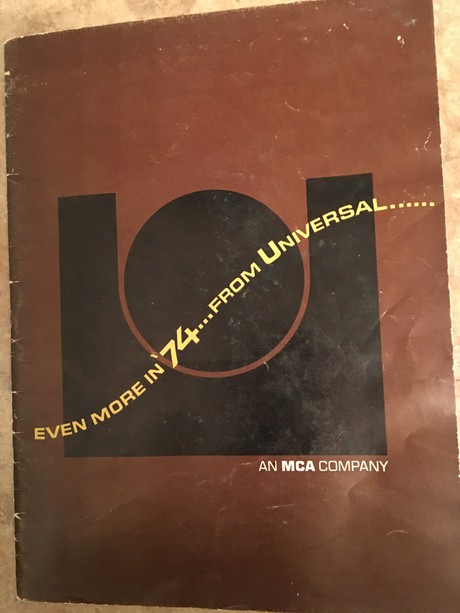
The book starts by showing off two of Universal's bigger hits: American Graffiti and The Sting.
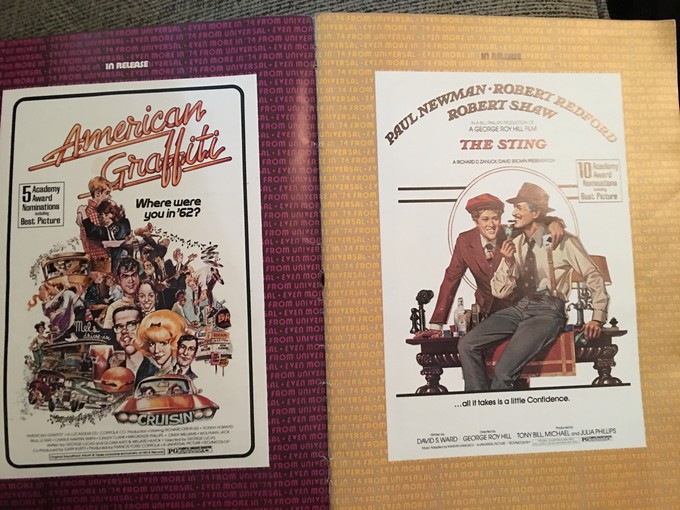
The next two pages start bridging the “currently in release” to the “coming soon” part of their slate, starting with Roland Kibbee and Burt Lancaster's murder mystery The Midnight Man (which I had never heard of until cracking this book open... I wonder whodunit? I've narrowed it down to “The Lesbian” or “The Sadist” out of that list) and the “completed” production of a Goldie Hawn vehicle called The Sugarland Express directed by some young punk named Steven Spielberg.
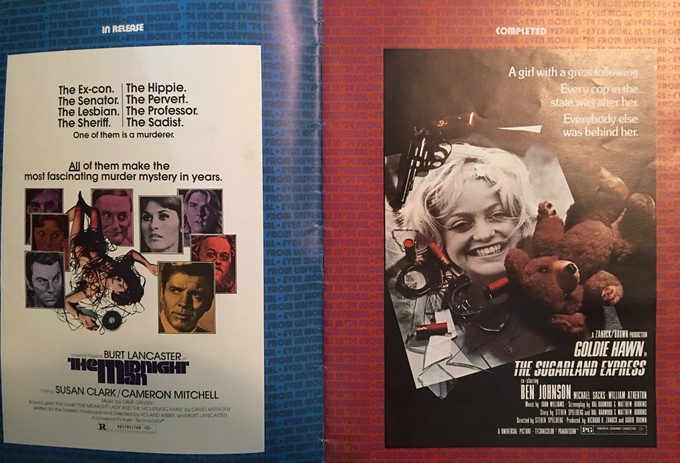
Next up are two interesting films, both films that were made and released. My Name Is Nobody is a quite good comedy western starring Henry Fonda and Terence Hill, produced and conceived by noneother than Sergio Leone. The art presented here is great and different from the art eventually used. The second is for a Don Siegel movie starring Michael Caine that was released as The Black Windmill (it's great, seek it out if you can), but it wasn't always called The Black Windmill. Here the movie is advertised under it's “tentative title” of Drabble. Good move on that name change, 1970s Universal Execs!
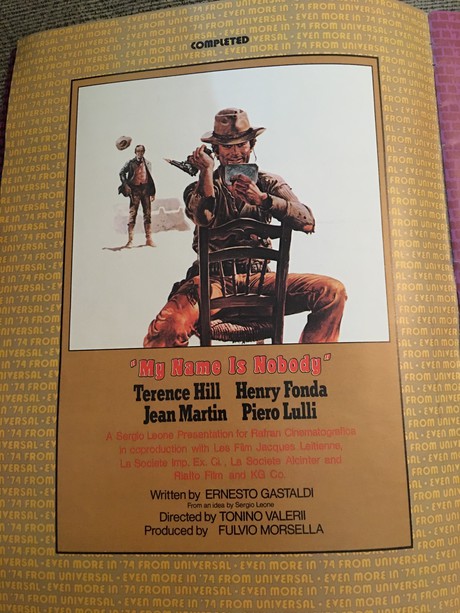
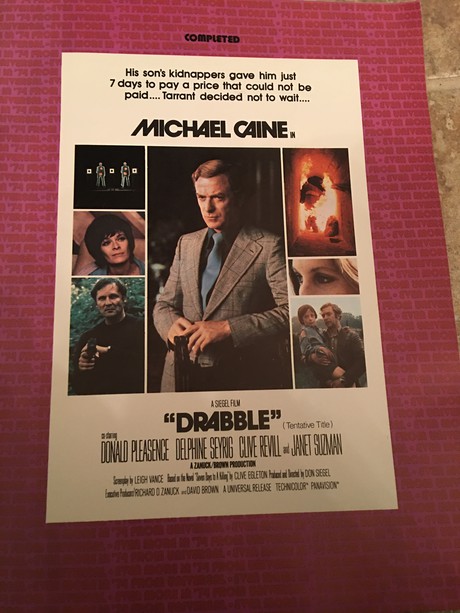
Now we're starting to get into some interesting territory. The next film on the slate was a small film using the working title “Teenager.” It was released three years after this went out as Jim, The World's Greatest, a movie few have seen, but is of great interest to horror fans because it's Don Coscarelli's first movie. Three years after Jim, The World's Greatest saw release Coscarelli set the genre world on fire with Phantasm, starring a man he worked with first on this movie. You can see Angus Scrimm (who worked under his real name of Rory Guy) in the collage below. Interesting how hot they were on pushing Don and his co-director Greg Harrison as child prodigy directors. Check it out:
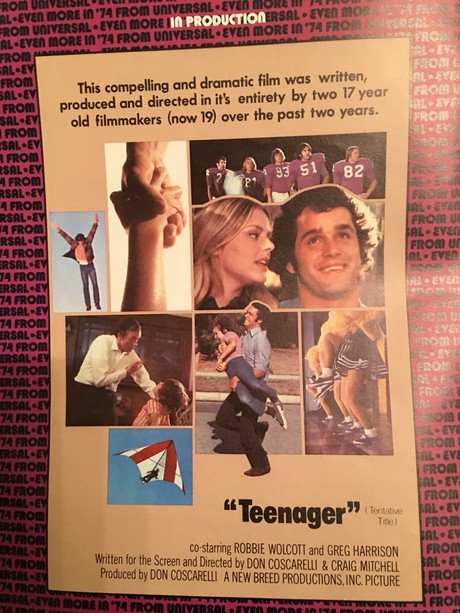
Next up is one of the more dull entries, a forgettable George Peppard cop flick called Newman's Law. Same poster art used for release.
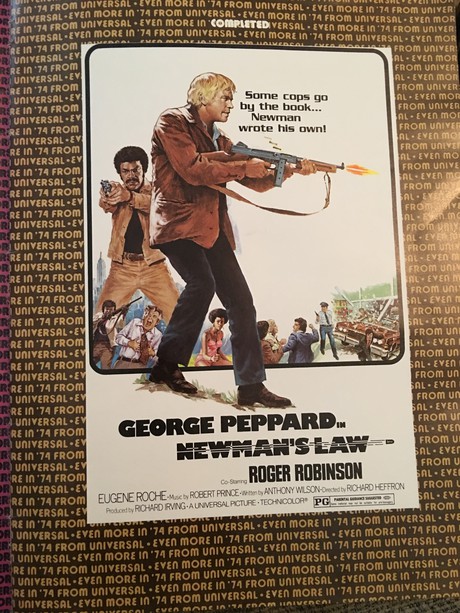
Next page props up a now forgotten movie. The movie advertised is “Sidecar Boys” but the film was released in 1975 as “Sidecar Racers.” Only 47 people have rated it on IMDB, which means it's one of those films that has slipped through the cracks. From what I gather it's some kind of surfer/biker movie. The tag line on the release one-sheet was “Two Guys, One Girl, and No Brakes!”

The next few pages are for films that were released, some more well-known than others. You have The Girl From Petrovka, a romantic drama in which Goldie Hawn played a Russian ballerina who falls in love with Hal Holbrook's US reporter character, then the disaster epic Earthquake (with poster art close to the art on the one-sheet, but a little different) and George Roy Hill's The Great Waldo Pepper, starring Robert Redford (again, different art than what ended up on the one-sheet).

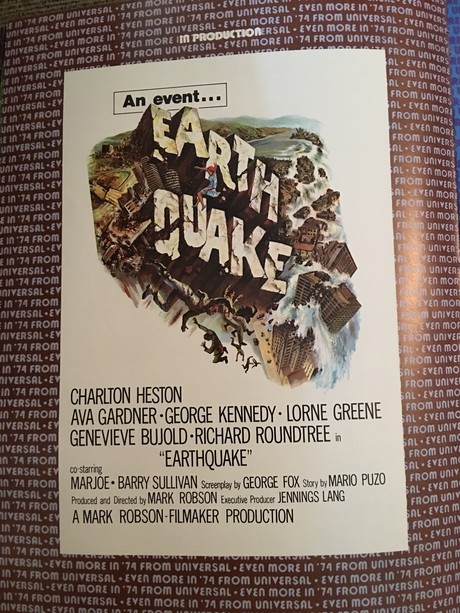
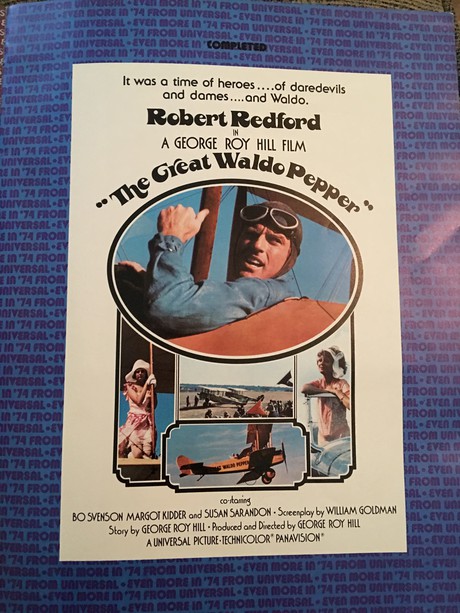
This next one is interesting because it's for a movie “In Production” that ended up happening, but not with the advertised star. The Great Scout and Cat-House Thursday isn't the most famous movie, but it's a worth-watching comedy western starring Lee Marvin, Oliver Reed and Robert Culp. Apparently James Garner was the original star. I don't know exactly who replaced him, but I'd guess it was Robert Culp.
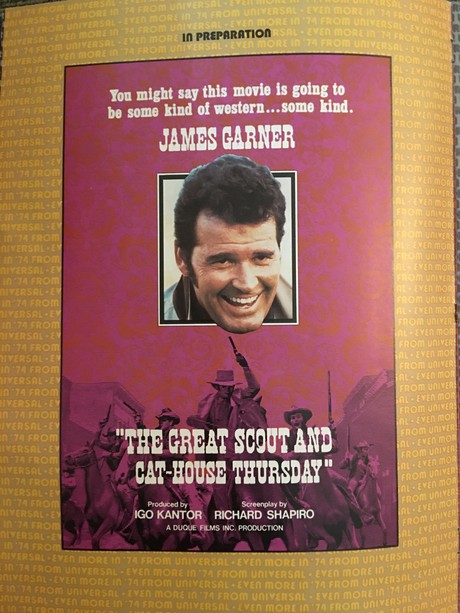
The next three titles are all movies that happened with the cast and filmmakers announced, but what's interesting about all three is the art used. Billy Wilder's The Front Page shows off the dynamic duo of Walter Matthau and Jack Lemmon in an image that was not used in the film's final advertising, Robert Wise's disaster flick The Hindenburg uses rough mock-up art to show the scale of the movie without any of the stars who would end up in the movie (I'd guess because George C. Scott and Anne Bancroft hadn't been cast yet) and then there's Clint Eastwood's The Eiger Sanction, which uses the famous art that would end up on the poster, but oddly doesn't mention Eastwood as director yet.
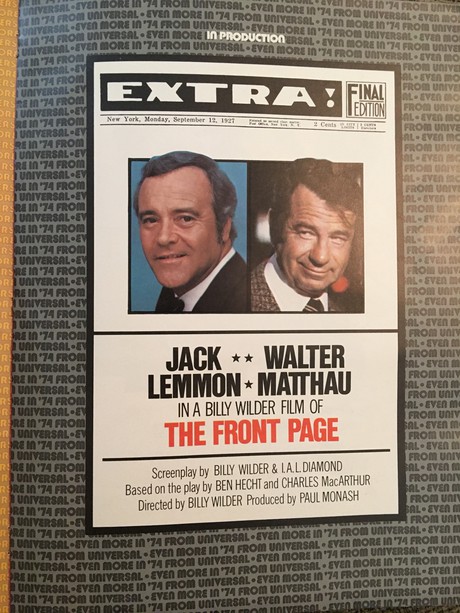
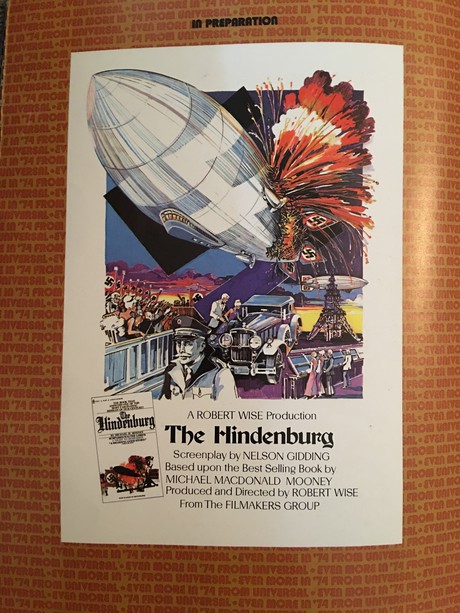

Now it's time for our first “What the hell is this!?!” in the book. What you have here is art for an Alan J. Pakula film called One More Song. Unless I'm blind, this film never happened. No cast was announced, but it appeared to be a comedy set in and around striking it rich with oil. The script was written by Stanford Sherman, who up to that point was most well known for his work on the '66 Batman show. He'd go on to write Any Which Way You Can, Krull and Ice Pirates. Yeah. Instead of making this one, Pakula went on to do The Paralax View and one of the best movies of the '70s (and that's saying something), All the President's Men, starring Robert Redford who has his own never made movie, but we'll get to that after you check out the art for One More Song.
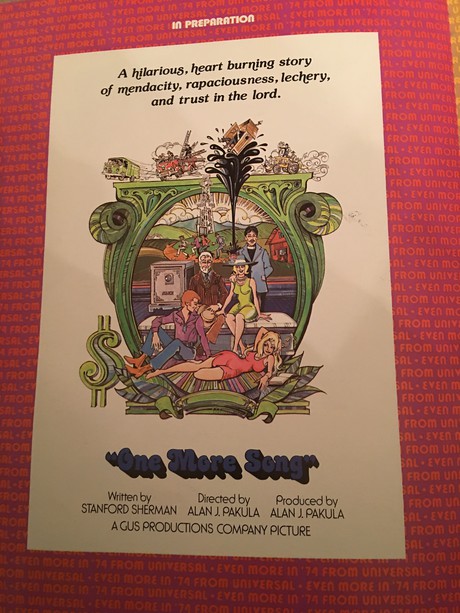
Here's another one that never made it to film, a project called Mayberly's Kill, produced by Zanuck/Brown (the team behind Sugarland Express and another obscure Spielberg movie we're about to get to), written by The Prime of Miss Jean Brodie's Jay Presson Allen and starring Robert Redford. I assume it was an adaptation of a book by the same name by William O. Turner, which looks to have been a bounty hunter story about a guy on the trail of some outlaws who have murdered and kidnapped their way across the west. It's hard to find material on this book, but I read a review that said it read more like a pulpy private dick novel than a hard western. Anyway, it's a neat “what could have been.”
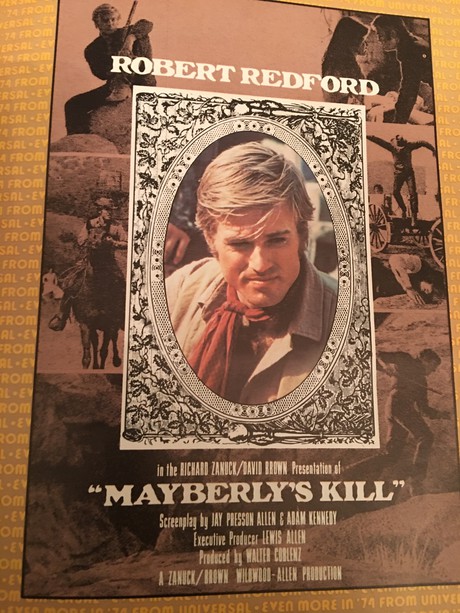
The next two movies are films that you should know, even though they don't mention a title for the latter production. You got Airport 1975, the sequel to the highly successful disaster film Airport. No cast is announced, but the film would end up starring Charlton Heston, George Kennedy and Karen Black.
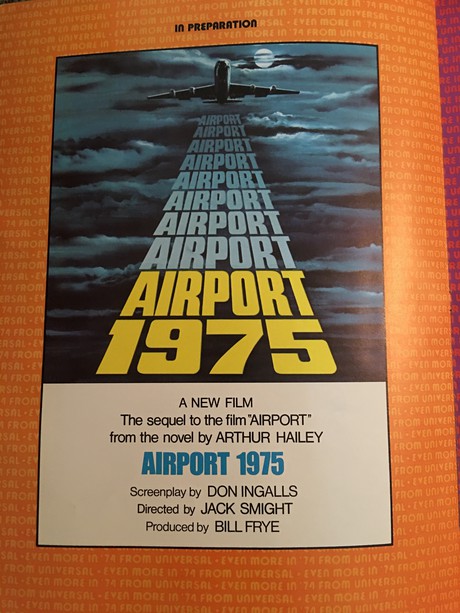
Now we have an untitled Hitchcock movie that would end up being the maestro's final film. Based on a book called The Rainbird Pattern, he'd end up calling it Family Plot.
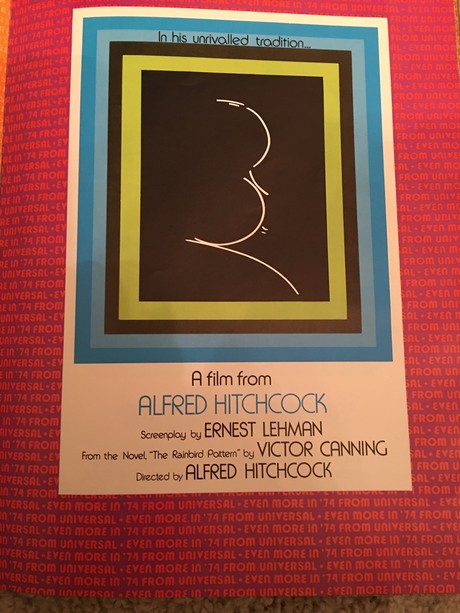
This is one of my favorite weird-o unmade projects featured in the book. It's for what appears to be some kind of post-apocalyptic exploitation movie from the minds of Hal Barwood and Matthew Robbins, two people who worked with George Lucas and Steven Spielberg early in their careers. Barwood wrote Sugarland Express, worked on THX 1138, wrote Corvette Summer, Dragonslayer and was behind a great deal of the Indiana Jones games from LucasArts, like Fate of Atlantis and The Infernal Machine. Robbins also worked on THX, did some uncredited script work on Close Encounters of the Third Kind and more recently has done a lot of work with Guillermo del Toro, including Crimson Peak and his At the Mountains of Madness project. This one was to be called CLEARWATER. I looked for info on this one and only came up with an umade project from Barwood and Robbins called Star Dancing from around this time period, but it doesn't seem to fit with this poster art. Check it out:
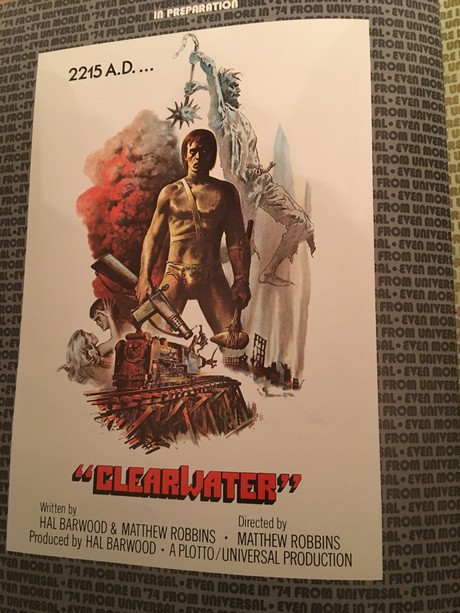
Speaking of George Lucas... At this point he was coming off of a huge hit with American Graffiti and had a few ideas bouncing around. One of them was a crazy space opera, but he hadn't written his first draft of Star Wars yet (which he would take to Universal and it wouldn't go anywhere at that studio). He had another idea for a movie that he was hot on directing called Radioland Murders. He'd eventually produce this film 20 years later for another director, but this image promises a Radioland Murders directed by Lucas, produced by Gary Kurtz and written by his Graffiti team of Willard Huyck and Gloria Katz (who would later pen Temple of Doom). If he had made this film odds are he would have been distracted away from pursuing Star Wars, which would have changed cinema in massive ways that we can't even comprehend at this point. It's a really cool image, too. Makes it seem way more sinister than the movie we eventually got.
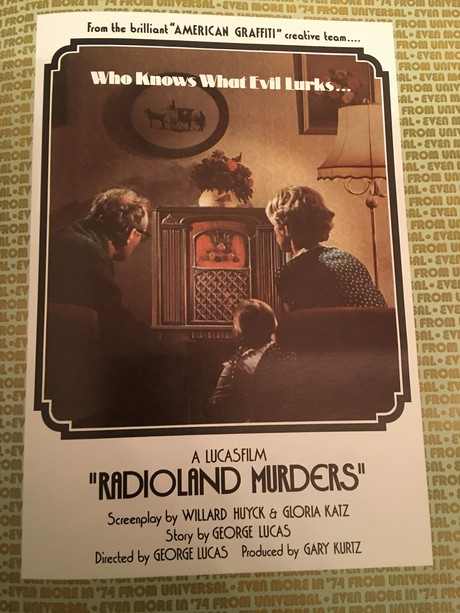
The next spread is a little less interesting, but you get the “Holy shit, we're making a sequel to True Grit!” and a Douglas MacArthur biopic that would take a few years to actually get made, but would be directed by Joseph Sargent and star Gregory Peck (released in 1977).

Now we come to the reason I bought this promo book off of eBay some 10-ish years ago. My obsession with Jaws drew me to this book because it features the very first piece of art associated with the movie, an image which was never used outside of this promo book letting us know it was in development. I had seen this image all pixelated and small, but wanted to examine it close up and it did not disappoint. I assume this is a rendering of the original ending for Hooper's character. The film was a half year away from shooting at the point this was sent out and Peter Benchley is the only screenwriter mentioned. I've read his script and it bears very little resemblance to what they ended up shooting, which was a combination of Benchley's base, Howard Sackler's uncredited work, Carl Gottlieb's on-set punch-ups and additions by Spielberg himself, John Milius and Robert Shaw. So, here's the really awesome promo art that made me seek this thing out in the first place:
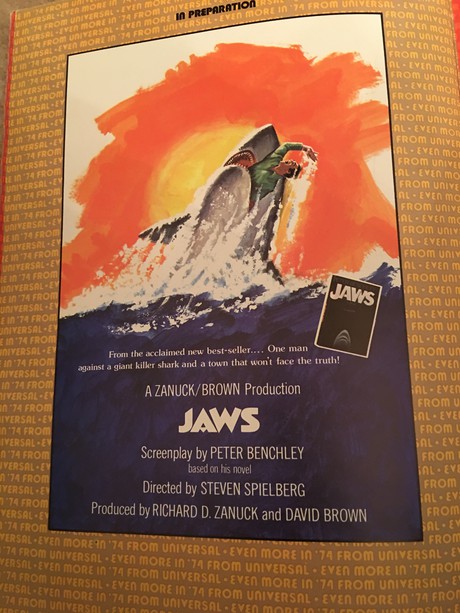
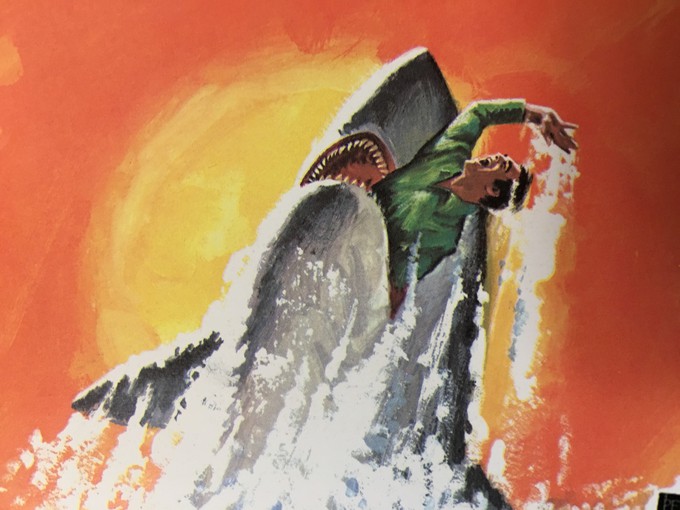
Speaking of Howard Sackler, he had his hands on the next project, a Peter Bogdanovich movie that he never made based on the life of gangster Bugsy Siegel. This one has no relation to the Warren Beatty flick that would be made two decades later. Sackler would later write Saint Jack for Bogdanovich, but this one never moved forward.

This one's a little boring, sorry. It's for an obscure 1975 release called The Other Side of the Mountain that ended up starring Beau Bridges and Marilyn Hassett, a romantic drama about a paralyzed skier. It is interesting that they used this art, though, which never saw any other advertising use.

After his one-two punch of The French Connection and The Exorcist, Universal nabbed William Friedkin's next movie, which at the time of this book going out was obviously something they were still figuring out. I'm very curious as to what was thought about in this time. Was it always Sorcerer, which Universal released in 1977 or did they kick around a few other ideas in the three years between the printing of this and production on Sorcerer?
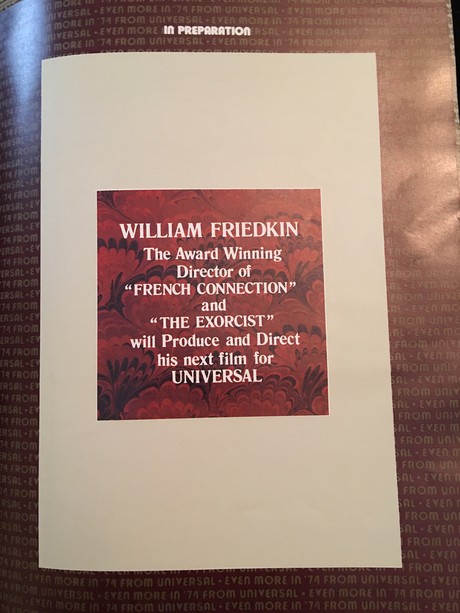
We're getting near the end now. Here's a Don Siegel movie that never made it called Paradise Mountain. Judging by the poster art it has something to do with an army dude being really mad at doctors for some reason. Tom Weitzner wasn't a screenwriter of note, with only a couple of TV credits to his name (ITV Television Playhouse and The United States Steel Hour). Siegel's next movie was The Shootist with John Wayne.
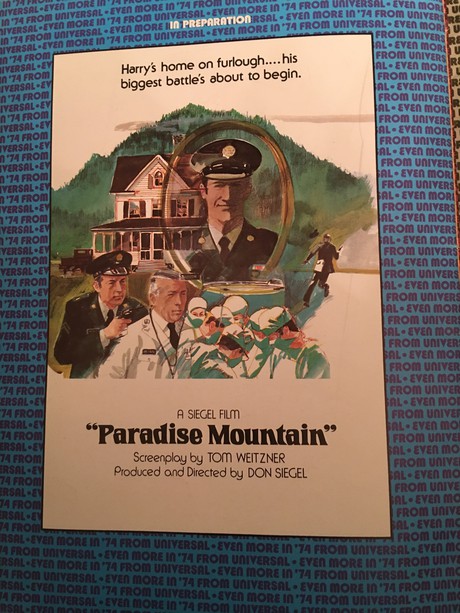
The final page in the book excitedly announces an exclusive partnership with production company The Mirisch Company, who had successfully produced a lot of big hits, like The Magnificent Seven, West Side Story, The Great Escape, The Pink Panther, In the Heat of the Night, The Party and The Thomas Crown Affair. The output Universal got wasn't really up to that level of quality, but the partnership did produce Midway, Grey Lady Down, Same Time Next Year, the Frank Langella Dracula and The Prisoner of Zenda, starring Peter Sellers.
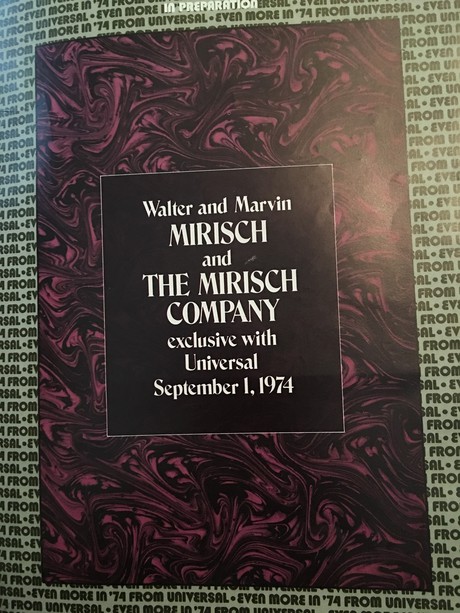
And that leaves only the back cover...
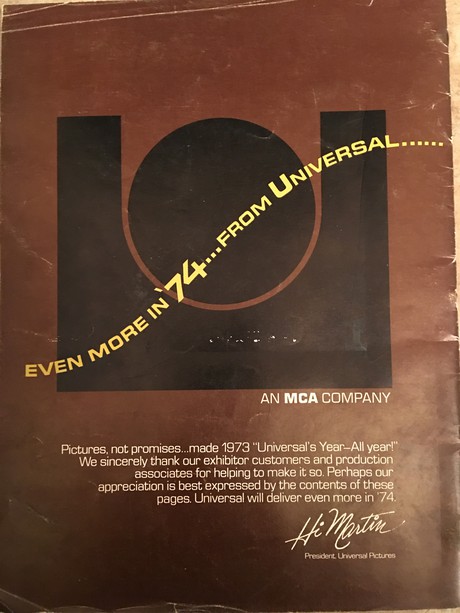
Hope you guys enjoyed that look back at what was and what could have been. I'm super intrigued by this kind of stuff and if you folks dig this article I might go out and seek out some more. Most major studios sent out similar books to exhibitors every year. That kind of turned into ShoWest being set up so they could cater directly to theater owners, but there's gotta be a ton of material out there just waiting to be ogled by cinephiles!
What was your favorite piece here? A different look at something you already knew, like that Jaws image, or a possible project that never came to pass? Let me know in the talkbacks below or via email!
Thanks for reading along!
-Eric Vespe
”Quint”
quint@aintitcool.com
Follow Me On Twitter

